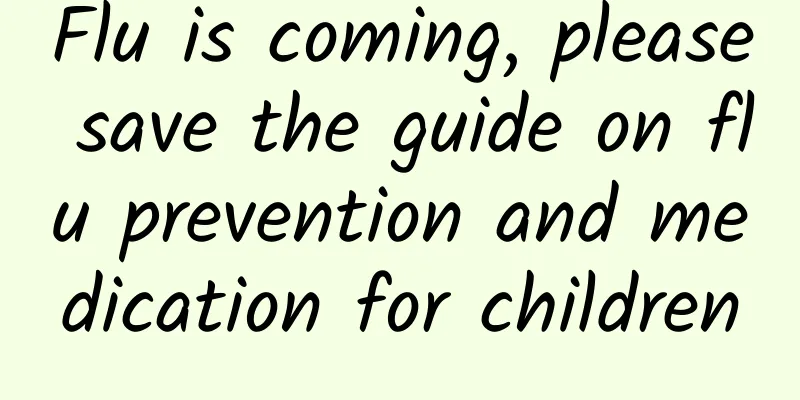Flu is coming, please save the guide on flu prevention and medication for children

|
Seasonal outbreaks of influenza It always sneaks into our lives quietly when the seasons change. Many times, children and adults In case of high fever, cough, headache, After muscle soreness and other symptoms, I was shocked to find out that I had been infected with the flu virus! Parents: Doctor, what should we do if so many people are infected? What medicine should we take? Doctor: After getting the flu, the high fever, sore throat, fatigue, body aches and other discomforts caused by the disease will make us lose our appetite and feel haggard. Therefore, the best way to deal with the flu is to prevent it before it happens. Image source: pixabay Flu prevention measures General precautions 01Maintain good hygiene habits Wash your hands frequently: especially when you come home from outside, before eating, and after coughing or sneezing. Avoid touching your mouth and nose: Try to avoid touching your mouth, nose, eyes and other parts with unwashed hands to reduce the possibility of virus invasion. Etiquette when coughing and sneezing: Cover your mouth and nose with a tissue or your elbow to prevent the spread of droplets. 02Environmental sanitation and disinfection Clean your home and work environment regularly: Use disinfectant to clean high-frequency contact surfaces such as door handles, mobile phones, keyboards, etc. Keep the air circulating: Open windows frequently to ventilate, keep the indoor air fresh and reduce the virus concentration. 03Healthy Lifestyle Balanced diet: Get enough nutrition to enhance immunity. Moderate exercise: Older children can maintain moderate exercise to improve their body immunity. Get enough sleep: Make sure you get enough sleep every day to avoid excessive fatigue. 04Avoid close contact Try to minimize close contact with influenza patients and avoid going to crowded public places, especially during the peak influenza season. Flu vaccination 01 Flu vaccination is effective Flu vaccination is one of the most effective measures to prevent influenza. It not only reduces the risk of influenza infection, but also reduces the chance of serious complications after contracting influenza. Flu vaccines usually produce antibodies about 2 weeks after vaccination, and the effective protection period is 6 months to 1 year. 02Priority vaccination targets The "Guidelines for Diagnosis, Treatment and Prevention of Influenza in Children 2024" recommends that all people aged ≥6 months with no contraindications to vaccination receive influenza vaccination, and recommends the following groups as priority recipients: (1) Children aged 6 to 59 months; (2) Family members and caregivers of infants under 6 months old; (3) People in key places such as childcare institutions, primary and secondary schools, etc. 03Vaccine Types The influenza vaccines approved for marketing in my country include trivalent inactivated vaccine (IIV3), trivalent live attenuated vaccine (LAIV3), and quadrivalent inactivated vaccine (IIV4). IIV3 and IIV4 are available in split and subunit forms and can be used for vaccination of people aged ≥6 months, including 0.25mL and 0.5mL dosage forms; LAIV3 is a freeze-dried preparation for use in people aged 3 to 17 years, with each dose being 0.2 mL. For people who can be vaccinated with different types of vaccines from different manufacturers, they can voluntarily receive any influenza vaccine, and there is no priority recommendation. 04Vaccination time It is recommended that vaccination be completed before the local influenza epidemic season, and vaccination can be completed throughout the epidemic season. In the same influenza epidemic season, people who have completed the full vaccination according to the vaccination procedure do not need to be vaccinated again. Proper personal hygiene habits, environmental cleaning and influenza vaccination are effective ways to comprehensively prevent and control influenza. Active prevention and timely vaccination, Not only can you protect yourself and your family, It also helps reduce the burden on public health. But if the flu virus breaks through the defense line Made the children sick We cannot "fight an unprepared battle" Let’s take a look at After getting the flu, How should children use medicine? Flu medication tips How to use the medicine 01 For babies with influenza, it is necessary to evaluate the baby's general condition, the severity of the disease, the onset of symptoms, the local influenza epidemic situation and many other factors to determine the treatment plan for influenza babies. Generally, it is recommended to give empirical antiviral treatment within 48 hours after the onset of the disease, and early treatment is more effective. However, antiviral treatment is still effective 48 hours after the onset of influenza-like symptoms. 02 At present, specific anti-influenza virus drugs that can be used clinically include arbidol, oseltamivir, zanamivir, peramivir, favipiravir, and mabaloxavir. 03 For healthy babies over 5 years old with mild flu symptoms, you can temporarily stop taking medicine and observe at home, take protective measures to avoid infecting others. Get more rest, drink more water, treat the symptoms when fever occurs, and use anti-flu virus drugs and seek medical attention in time if symptoms worsen. Usage, dosage and course of treatment of anti-influenza virus drugs Note: The chart is quoted from "Guidelines for Diagnosis, Treatment and Prevention of Influenza in Children (2024 Edition)", Chinese Journal of Practical Pediatrics, 2024, 39 (12) Precautions for taking medicines for babies at high risk of influenza Who are high-risk babies? Babies younger than 5 years old (especially younger than 2 years old), premature infants, those with underlying diseases, or primary or secondary immunodeficiency are at higher risk of severe illness and death after contracting influenza. In addition, prolonged fever after influenza, wheezing or shortness of breath during the course of the illness, and combined invasive bacterial infections are also risk factors for babies to develop severe influenza. High-risk babies should take medicine as early as possible For high-risk babies, even if the symptoms are mild, it is recommended to use anti-influenza virus drugs as soon as possible. Oseltamivir, zanamivir, and peramivir can be chosen. Babies over 5 years old can also use mabaloxavir. Observe adverse drug reactions Oseltamivir may cause adverse reactions such as nausea and vomiting in babies. For these babies, oseltamivir can be taken with food to improve drug tolerance. Although mabaloxavir is less likely to cause nausea and vomiting, it may still cause gastrointestinal discomfort. Mabaloxavir can also be taken with food, but it should be avoided with dairy products, calcium-fortified beverages, laxatives containing high-valent cations, antacids, or oral supplements (such as calcium, iron, magnesium, selenium, or zinc). After understanding the above little knowledge, I believe it can help everyone when facing the flu No more panic and helplessness. The flu comes with great force, but there are ways to deal with it. Early diagnosis and early treatment will cure the disease and improve your health! References: [1] “Guidelines for the diagnosis, treatment and prevention of influenza in children (2024 edition)”, Chinese Journal of Practical Pediatrics, 2024, 39(12) [2] Practical Guidelines for Influenza Vaccine Prevention and Antiviral Drug Use in Children (2024 Edition), Chinese Medical Journal, 2024, 104 (40) Source: Children's Hospital Affiliated to Chongqing Medical University Author: Chang Yunan, Chen Rui Review expert: Zhang Zhenzhen, chief physician Statement: Except for original content and special notes, some pictures are from the Internet. They are not for commercial purposes and are only used as popular science materials. The copyright belongs to the original authors. If there is any infringement, please contact us to delete them. |
<<: "Medicine" is not allowed | Do not drive a vehicle after taking Zolpidem
Recommend
Will eating aspartame for so many years have any effect on the body?
Audit expert: Wang Guoyi Postdoctoral fellow in N...
Can women eat mulberries during menstruation?
Women are prone to some uncomfortable symptoms du...
Is it normal to have your period five days early?
Female friends have menstruation every month. If ...
Is it normal to vomit in 3 months of pregnancy?
It is very normal for pregnant friends to experie...
What are the causes of miscarriage one week after amniocentesis?
Pregnant women should go to the hospital for regu...
Frequent use of this thing on the face can actually lead to disfigurement
In the eyes of many women, applying cucumber on t...
What to do if you can't get pregnant after a miscarriage?
Pregnancy is a very happy thing for many women, b...
Where to apply moxibustion for endometriosis
Moxibustion is a very popular treatment method no...
What is endometrial odor?
Have you ever encountered endometrial odor? Maybe...
World Oral Health Day: Chewing betel nuts, smoking... these high-risk behaviors that cause oral cancer should be stopped!
Your browser does not support the audio tag "...
Lower abdominal pain and vaginal bleeding
Nowadays, many older women experience lower abdom...
What are the causes of uterine infertility?
The uterus is the cradle of the baby. Any abnorma...
Original comic book about dizziness and popular science: Crazy Stone: Journey to the West
1. It is said that Tang Monk and his three discip...
Yellow discharge after menopause
Menstruation is a unique physiological phenomenon...
Do French fries have to be soaked in salt water? Why do French fries need to be soaked in salt water?
We all know that French fries are a common snack....









